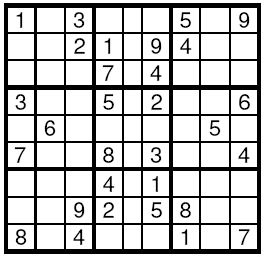Sudoku
| Time Limit: 2000MS | Memory Limit: 65536K | |||
| Total Submissions: 21946 | Accepted: 10406 | Special Judge | ||
Description
Sudoku is a very simple task. A square table with 9 rows and 9 columns is divided to 9 smaller squares 3x3 as shown on the Figure. In some of the cells are written decimal digits from 1 to 9. The other cells are empty. The goal is to fill the empty cells with decimal digits from 1 to 9, one digit per cell, in such way that in each row, in each column and in each marked 3x3 subsquare, all the digits from 1 to 9 to appear. Write a program to solve a given Sudoku-task.


Input
The
input data will start with the number of the test cases. For each test
case, 9 lines follow, corresponding to the rows of the table. On each
line a string of exactly 9 decimal digits is given, corresponding to the
cells in this line. If a cell is empty it is represented by 0.
Output
For
each test case your program should print the solution in the same
format as the input data. The empty cells have to be filled according to
the rules. If solutions is not unique, then the program may print any
one of them.
Sample Input
1 103000509 002109400 000704000 300502006 060000050 700803004 000401000 009205800 804000107
Sample Output
143628579 572139468 986754231 391542786 468917352 725863914 237481695 619275843 854396127
分析:DFS暴力啊。。。

#include<cstdio> #include<cstring> int map[10][10]; int node[100][2];//记录空格 int c[10][10],r[10][10];//记录,行列状态 int g[10][10];//3*3,9个3*3的格见下图 /* 111222333 111222333 111222333 444555666 444555666 444555666 777888999 777888999 777888999 */ int N,flag; void dfs(int cur) { if(cur==N) { flag=1; return; } int x=node[cur][0],y=node[cur][1]; int t=(y-1)/3+(x-1)/3*3+1; for(int i=1;i<10;i++) { if(!c[x][i]&&!r[y][i]&&!g[t][i]) { map[x][y]=i; c[x][i]=r[y][i]=g[t][i]=1; dfs(cur+1); if(flag) return; c[x][i]=r[y][i]=g[t][i]=0; map[x][y]=0; } } return; } int main() { int T; scanf("%d",&T); while(T--) { flag=N=0; memset(c,0,sizeof(c)); memset(r,0,sizeof(r)); memset(g,0,sizeof(g)); for(int i=1;i<10;i++) { for(int j=1;j<10;j++) { scanf("%1d",&map[i][j]); //记录空格 if(map[i][j]==0) { node[N][0]=i; node[N][1]=j; N++; } else { c[i][map[i][j]]++;//第i行有了map[i][j]这个数 r[j][map[i][j]]++;//第j列有了map[i][j]这个数 g[(j-1)/3+(i-1)/3*3+1][map[i][j]]++;//3*3 } } } dfs(0); for(int i=1;i<10;i++) { for(int j=1;j<10;j++) printf("%d",map[i][j]); printf(" "); } } return 0; }
